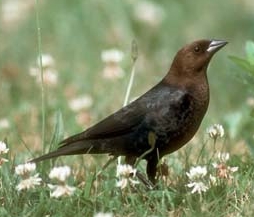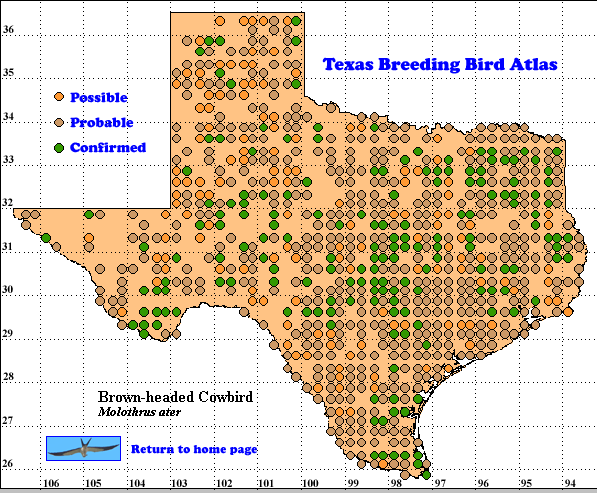The most widespread and familiar of North American cowbirds were once know as “buffalo birds.” They followed herds of these large mammals, eating the insects stirred up by the grazing animals on the Great Plains. This nomadic existence required the cowbirds to adopt a brood parasite strategy, leaving their eggs in the nests of other birds who then raised the young cowbirds (Lowther 1993).
In winter these cowbirds are often found in large foraging flocks of as many as 2 million individuals. The flocks may include other blackbirds as well as starlings foraging at sources of ample seeds and insects. Agricultural activities such as feed-lots, rice fields and recently harvested areas are often used (Lowther 1993, Lockwood and Freeman 2004).
DISTRIBUTION. During the 1987-1992 field work seasons of the TBBA project, atlasers found confirmed breeding evidence for Brown-headed Cowbirds in 259 blocks, probable evidence in 929 blocks and possible in 486 blocks in all eco-regions of Texas.
Range overlap with Bronzed Cowbirds (Molothrus aeneus) occurs mostly in south Texas, although this species was found by TBBA atlasers as far north as the Panhandle and west into the Trans-Pecos. Within the overlap zone, a Red-winged Blackbird (Agelaius phoeniceus) nest was found containing eggs of both cowbird species (Harrison 1979).
In Oklahoma atlasers found confirmed breeding evidence for Brown-headed Cowbirds at 176 sites, probable at 277 sites and possible at 78 sites in all counties of the state (Scor 2004).
North American Breeding Bird Survey (BBS) observers reported Brown-headed Cowbirds in all 48 contiguous United States, the western Canadian provinces and the southern fringes of eastern provinces (Sauer et al. 2008). This species is resident in Mexico south to the Isthmus of Tehuantepec. In winter many northern interior birds move to more moderate areas of the breeding range (Lowther 199, Howell and Webb 1995, Am. Ornithol. Union 1998).
SEASONAL OCCURRENCE. Brown- headed Cowbirds are year-round residents of Texas. Numbers decline in winter in the Trans-Pecos as many cowbirds move south or join flocks at feed-lots. At the same time numbers in the eastern half of the state are increased by northern migrants. Breeding takes place from mid-March to early September, based on egg collection dates from March 29 to August 5 (Oberholser 1974, Lockwood and Freeman 2004).
BREEDING HABITAT. Although Brown- headed Cowbirds are found in a wide variety of habitats, they prefer short-grass vegetation, with or without scattered trees, woodland edges, brushy thickets and similar human-created areas (Lowther 1993, Chace 1998, Averill-Murray 2005). BBS volunteers found the highest relative abundances for this species in the Dakotas, Nebraska and Kansas with cowbird counts for 40 km (25 mi) routes ranged from 30-100 per year (Sauer et al. 2008).
Prolific female cowbirds can lay as many as 40 eggs per season, usually in “sequences” of 1-7 eggs, laid one a day, before taking a short rest. These cowbirds parasitize a wide variety of small passerines. The most common host is the Yellow Warbler (Dendroica petechia), a common breeder in the riparian corridors of the Great Plain (Lowther 1993)s.
Female cowbirds may remove a host egg, usually the day before or after laying an egg early in the morning when no host adult is at the nest. Punctures of eggs of potential hosts may also be the work of cowbirds. Hosts may use a variety of strategies other than accepting the egg, such as removing the egg, building a new nest atop the one with the alien egg or abandoning the nest. A 6-tiered Yellow Warbler nest containing 11 cowbird eggs has been found. Female cowbirds may lay eggs in nests still under construction. Where cowbirds are plentiful, several females may lay as many as 9 eggs in the same nest (Harrison 1979, Lowther 1993, Tweit and Thompson 1999).
After incubation by the hosts, cowbird eggs hatch in 11-12 days. Cowbird young often grow faster than host nest mates and leave the nest 8-13 days after hatching. They continue to be fed by their hosts for 25-39 days before becoming independent (Lowther 1993).
STATUS. Brown-headed Cowbirds are common to locally abundant residents of Texas (Oberholser 1974, Lockwood and Freeman 2004). BBS data from 200 routes in Texas provide a statistically significant annual population change of -2.6% for the period 1980-2007. Although this decline is larger than the compatible North American figure of -1.0% (Sauer et al. 2008) it may be due to habitat loss which would also impact host species. Text by Robert C. Tweit (2009)
Chace, J. F. 1998. Brown-headed Cowbird (Molothrus ater). In Colorado breeding bird atlas, pp. 514-515 (H. E. Kingery, ed.), Colorado Bird Atlas Partnership, Denver.
Sauer, J. R., J. E. Hines, and J. Fallon. 2008. The North American breeding bird survey, results and analysis 1966-2007. Version 5.15.2008. USGS Patuxent Wildlife Research Center, Laurel MD < http://www.mbr-pwrc.usgs.gov/bbs>
Scor, K. S.. 2004. Brown-headed Cowbird (Molothrus ater). In Oklahoma breeding bird atlas, pp. 446-447 (D. L. Reinking, ed.). University of Oklahoma Press, Norman.
Tweit, R. C. and C. W. Thompson. 1999. Pyrrhuloxia (Cardinalis sinuatus), The Birds of North America Online (A. Poole, Ed.). Cornell Lab of Ornithology; Ithaca, NY. Retrieved from: http://bna.birds.cornell.edu/bna/species/391
Tweit, R. C. 2005. Bronzed Cowbirds (Molothrus aeneus). In Texas breeding bird atlas (K. A. Arnold and K. L. P. Benson, eds.), Texas A&M University, College Station. <http://txtbba.tamu.edu/>

